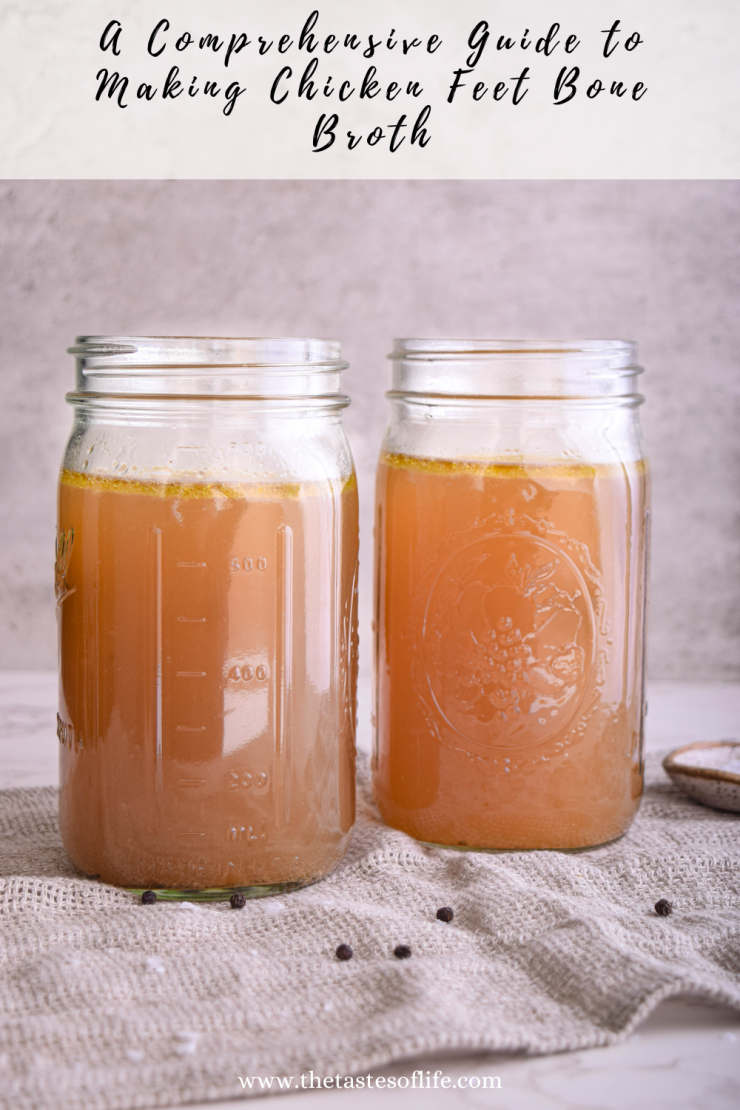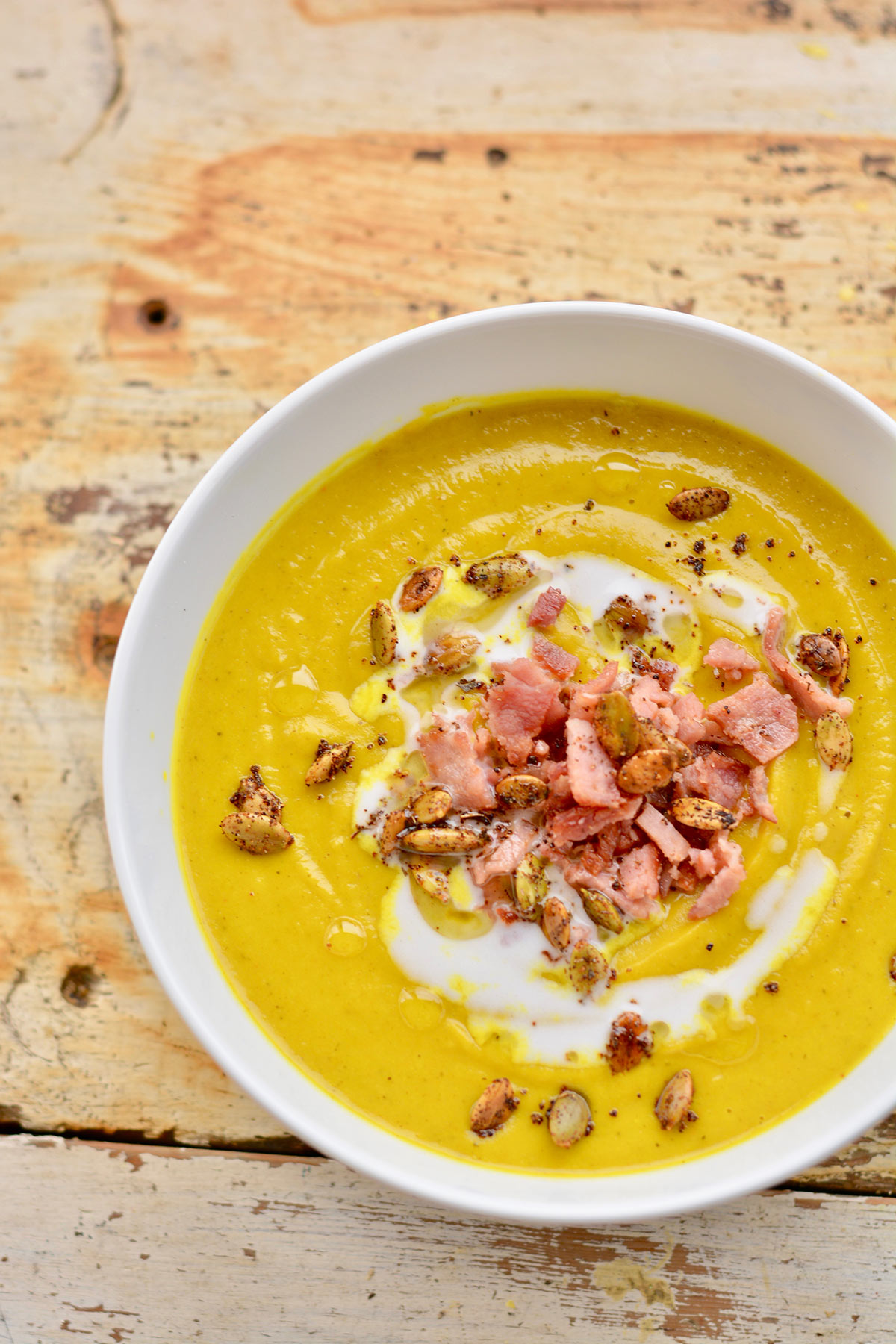A Comprehensive Guide to Making Chicken Feet Bone Broth
Sharing is caring❤️

Homemade Chicken Feet Bone Broth Recipe
This chicken feet bone broth is healthy, comforting, and easy to make! It is nutritious, full of trace minerals and collagen, great for bone health and the best bone broth you ever had.
Beyond its delectable taste and comforting warmth, this elixir has been revered for centuries across various cultures for its myriad health benefits. This comprehensive guide will delve into the art of crafting chicken feet bone broth, exploring its nutritional profile, and the step-by-step process to create this nourishing liquid gold as I call it!. Homemade bone broth is the best!
I was raised on chicken feet 😂😂 no kidding! It is a traditional food in my country. In Poland, we ate all parts of the animals because we knew that they had great nutritional benefits, especially organ meats and chicken feet. But I know that people would rather not know that the soup was based on chicken feet broth😂 My dogs love them, so we both benefit.
You are probably worried about the flavor but trust me; it is no different than a regular broth. Chicken feet don’t usually seem very appealing; I promise it’s delicious. It sounds gross because it’s just something Americans are not used to eating.
Bone broth has a long and storied history, originating in ancient civilizations. Bone broth has been a staple, valued not only for its culinary appeal but also for its perceived medicinal properties.
The Nutritional Powerhouse
Delving into the nutritional composition of chicken feet bone broth reveals a treasure trove of essential nutrients. From collagen and gelatin to minerals like calcium, magnesium, and phosphorus, this elixir provides a potent dose of nourishment. Uncover the science behind these nutrients and their potential health benefits, ranging from joint health to improved gut function. Bone broth is the best gut-healing food!

Is Chicken Feet Bone Broth Good for You?
Yes, chicken feet bone broth is highly nutritious and associated with various health benefits. Here are some reasons why chicken feet bone broth is considered good for you:
- Rich in Nutrients: Chicken feet contain a high amount of collagen, which is released into the broth during cooking. Collagen is a protein that provides structure to the skin, hair, nails, and connective tissues. Additionally, the broth contains essential minerals like calcium, magnesium, and phosphorus.
- Joint Health: The collagen in chicken feet bone broth may contribute to joint health. Collagen is a key component of cartilage; consuming it may help support joint function and reduce joint pain.
- Gut Health: The gelatin produced from the collagen in the broth is known to be beneficial for the digestive system. It may help soothe and heal the lining of the digestive tract, promoting a healthy gut.
- Amino Acids: The slow simmering process of making bone broth releases amino acids, which are the building blocks of proteins. These amino acids are essential for various bodily functions, including muscle repair and immune system support.
- Hydration and Electrolytes: Chicken feet bone broth is hydrating and contains electrolytes. This can be especially beneficial during illness or after intense physical activity.
- Skin Health: Collagen is often associated with improved skin elasticity and hydration. Consuming chicken feet bone broth may contribute to healthier skin.
- Easy to Digest: The nutrients in bone broth are in a form that is easy for the body to absorb. This can benefit individuals with digestive issues or those recovering from illness.
Is Chicken Feet Bone Broth Rich in Collagen?
Yes, chicken feet bone broth is particularly rich in collagen. Collagen is a protein found in connective tissues, skin, and bones of animals, and it is released into the broth during the slow cooking process. Chicken feet, in particular, contain a high concentration of collagen due to the presence of connective tissues and skin.
When you simmer chicken feet in water for an extended period, the collagen breaks into gelatin, giving the broth a thicker, more viscous consistency. This gelatin is not only responsible for the texture of the broth but also for providing various health benefits.
Consuming collagen through bone broth, including that made from chicken feet, is believed to support skin health, promote joint health, and contribute to the overall structural integrity of connective tissues in the body. It’s important to note that while the collagen content in bone broth is beneficial, the body also produces its own collagen. The additional collagen from foods like chicken feet bone broth can complement the body’s natural processes.
If you’re specifically looking to boost your collagen intake, including chicken feet bone broth in your diet can be a flavorful and nutritious way to do so.

What Amino Acids Bone Broth Contain And Why Are They Good For Our Health
Bone broth contains various amino acids, which are the building blocks of proteins. The amino acids found in bone broth include both essential and non-essential amino acids. Here are some critical amino acids present in bone broth and their potential health benefits:
- Proline: Proline is an amino acid that plays a crucial role in collagen formation. Collagen is necessary for the health of connective tissues, including skin, tendons, and ligaments. Proline is also involved in wound healing.
- Glycine: Glycine is an amino acid with anti-inflammatory properties. It is essential for synthesizing proteins and maintaining a healthy immune system. Glycine is also involved in the production of glutathione, a powerful antioxidant.
- Glutamine: Glutamine is the most abundant amino acid in the body and is essential for many bodily functions. It plays a role in gut health, supporting the integrity of the intestinal lining. Glutamine is also crucial for the immune system.
- Arginine: Arginine is involved in various physiological processes, including nitric oxide production, which helps regulate blood flow.
- Leucine, Isoleucine, and Valine (Branched-Chain Amino Acids – BCAAs): These amino acids are necessary for muscle protein synthesis. They are vital for athletes and individuals engaged in physical activity, contributing to muscle repair and growth.
- Lysine: Lysine is involved in collagen formation and plays a role in calcium absorption. It is essential for the growth and maintenance of bones.
- Serine: Serine is essential for synthesizing proteins, nucleotides, and other amino acids. It plays a role in cell growth and immune function.
- Cysteine: Cysteine is a precursor to glutathione, a powerful antioxidant that helps protect cells from damage. It also plays a role in the synthesis of proteins and detoxification processes.
These amino acids collectively contribute to the overall health of various bodily systems, including the musculoskeletal, immune, and digestive systems. The collagen and gelatin produced from the breakdown of connective tissues in bone broth provide a source of these amino acids, making bone broth a nutritious addition to a balanced diet.
How Do You Clean Chicken Feet For Broth?
You can usually buy already-cleaned chicken feet at the store. If your chicken feet resemble the ones shown in the photo above, they are ready for use. However, if they still have yellow skin, peeling may be necessary. Boiling them makes skin removal easier. Exercise caution when handling them while hot.
It’s essential to use chicken feet that are thoroughly clean. The ones I purchase come ready from the package. If yours appear a bit dirty, ensure they are impeccably cleaned before use.
Cleaning chicken feet:
If they don’t look clean, they require thorough washing and, in some cases, additional steps to remove any residual debris. Here’s a step-by-step guide on how to clean chicken feet for broth:

Ingredients and Tools:
- Chicken feet
- White vinegar or lemon juice
- Salt
- Cutting board
- Knife
- Kitchen shears
- Bowl
- Water
Steps:
Purchase Fresh Chicken Feet:
Start with fresh, high-quality chicken feet from a reputable source.
Trim Nails and Excess Skin:
Use kitchen shears or a knife to trim the nails and excess skin from the chicken feet. You may also remove any visible dirt or debris at this stage.
Scald with Boiling Water:
Pour boiling water over the chicken feet to scald them. This helps to remove the outer layer of skin and any remaining impurities. Allow the chicken feet to sit in the hot water for 1-2 minutes.
Rinse with Cold Water:
After scalding, rinse the chicken feet under cold running water to stop the cooking process. This step helps remove any scalded skin and ensures that the chicken feet are clean.
Soak in Vinegar or Lemon Water:
Fill a bowl with water and add a tablespoon of white vinegar or lemon juice. Soak the chicken feet in this solution for about 15-20 minutes. The acid helps further clean and sanitize the chicken feet.
Scrub with Salt:
Sprinkle salt on the chicken feet and use your hands or a brush to scrub them thoroughly. This step helps remove any remaining impurities and ensures a clean surface.
Rinse Again:
Rinse the chicken feet once more under cold running water to remove the salt and any loosened debris.
Inspect for Remaining Feathers or Debris:
Check each chicken foot for any remaining feathers or debris. Use kitchen shears or a knife to carefully remove any unwanted parts.
Pat Dry:
Pat the chicken feet dry with paper towels before using them in your broth.
Ingredients For Chicken Feet Bone Broth
- Chicken Feet: Approximately two pounds of chicken feet, cleaned and trimmed.
- Water: About 1/2 gallon, preferably filtered. Make sure that there is enough water in the pot.
- Vegetable Scraps: Onions, celery, carrots, or other aromatic vegetables for flavor.
- Fresh Herbs: Such as parsley, thyme, oregano, sage, or bay leaves for added freshness and complexity. You can also add ginger and turmeric.
- Apple Cider Vinegar: It helps pull out the nutrients from the bones.
- Salt
- Black pepper
Step-By-Step Instructions on How To Make Chicken Feet Bone Broth
Prepare the Chicken Feet:
- Ensure the chicken feet are thoroughly cleaned and trimmed. If the skin is yellow, consider peeling by boiling and handling them with caution when hot.
Vegetable and Herb Prep:
- Chop the aromatic vegetables (onions, celery, carrots) and gather the herbs.
Instant Pot Bone Broth Method:
- Place chicken feet in the Instant Pot.
- Add water, vegetable scraps, herbs, and a pinch of salt.
- Set the Instant Pot to low pressure for 240 minutes (4 hours).
- After cooking, allow for natural release or perform a quick release.
- Strain the broth using a fine mesh strainer, discarding solids.
- Transfer the broth to containers for storage.
Stove Top Method:
- Combine chicken feet, water, chopped vegetables, herbs, and salt in a large stock pot or Dutch oven.
- Bring the mixture to a simmer over medium heat.
- Reduce heat to low, cover with a lid, and let it simmer for 6-8 hours or longer.
- Skim off any foam that rises to the surface during the initial simmering.
- Strain the broth using a fine mesh strainer, removing solids.
- Store the broth in containers.
Slow Cooker:
- Combine chicken feet, water, veggie scraps, and herbs in the slow cooker.
- Cover and cook on low for 18-24 hours.
- Strain and store in the fridge.
How to Store Chicken Feet Broth
- Store in an airtight container in the fridge for up to 4 days.
- To freeze, use a freezer-safe bag or mason jar, leaving space for expansion, and store for up to 3 months.

What Can You Use Chicken Feet Broth For?
Yes, chicken feet are consumed in various cuisines worldwide, and there are different ways of preparing and eating them. Here are a few examples:
Sipping the Broth:
- Enjoy the chicken feet bone broth as a warm and comforting drink on its own.
- Sip it from a mug or bowl, especially during colder days or when you’re looking for a soothing beverage.
Base for Soups and Stews:
- Use the rich and flavorful chicken feet bone broth as a base for soups and stews.
- Add vegetables, grains, and proteins to create hearty and nourishing soup recipes.
Cooking Grains and Legumes:
- Use chicken feet bone broth to cook rice, quinoa, or other grains to infuse them with added flavor and nutrients.
- Cook lentils, beans, or legumes in the broth for a tasty and nutritious side dish.
Braising Meats:
- Use the broth as a braising liquid for meats. The collagen in the broth adds richness and depth to the flavor of braised dishes.
Making Sauces and Gravies:
- Reduce the chicken feet bone broth to create a concentrated and flavorful sauce or gravy for meats and vegetables.
Poaching or Steaming:
- Poach or steam seafood or vegetables in chicken feet bone broth for a unique and savory twist.
- This method imparts a subtle and delicious flavor to the ingredients.
Asian-Inspired Dishes:
- Explore Asian cuisine by using chicken feet bone broth in recipes like ramen or noodle soups.
- The gelatinous nature of the broth adds a luxurious texture to these dishes.
Drinking as a Health Tonic:
- Incorporate chicken feet bone broth into your daily routine as a health tonic.
- Drink a cup in the morning or before meals to benefit from its collagen and nutrient content.
Freezing in Ice Cube Trays:
- Freeze chicken feet bone broth in ice cube trays for convenient portioning.
- Pop a few cubes into sauces, stews, or soups for an instant flavor boost.
Enhancing Rice and Pasta Dishes:
- Use chicken feet bone broth to cook rice or pasta for added depth of flavor.
- It’s an excellent way to elevate the taste of simple dishes.
Where to buy chicken feet from:
Check local farms in the area
Whole Foods Market
Farmers Market
Local Farmer
Fed From The Farm
Azure Standard sells chicken paws. Chicken paws are mostly just the foot of the chicken and not much of the legs.
Check local grocery store
Primal Pastures
Local Butcher
Grass Roots
How To Eat The Chicken Feet Bone Broth
This chicken feet bone broth recipe can be enjoyed in various ways, depending on your preferences and culinary creativity. Here are several suggestions on how to eat and incorporate chicken feet bone broth into your meals:
Sipping the Broth:
- Enjoy the chicken feet bone broth as a warm and comforting drink on its own.
- Sip it from a mug or bowl, especially during colder days or when you’re looking for a soothing beverage.
Base for Soups and Stews:
- Use the rich and flavorful chicken feet bone broth as a base for soups and stews.
- Add vegetables, grains, and proteins to create hearty and nourishing soup recipes.
Cooking Grains and Legumes:
- Use chicken feet bone broth to cook rice, quinoa, or other grains to infuse them with added flavor and nutrients.
- Cook lentils, beans, or legumes in the broth for a tasty and nutritious side dish.
Braising Meats:
- Use the broth as a braising liquid for meats. The collagen in the broth adds richness and depth to the flavor of braised dishes.
Making Sauces and Gravies:
- Reduce the chicken feet bone broth to create a concentrated and flavorful sauce or gravy for meats and vegetables.
Poaching or Steaming:
- Poach or steam seafood or vegetables in chicken feet bone broth for a unique and savory twist.
- This method imparts a subtle and delicious flavor to the ingredients.
Asian-Inspired Dishes:
- Explore Asian cuisine by using chicken feet bone broth in recipes like ramen or noodle soups.
- The gelatinous nature of the broth adds a luxurious texture to these dishes.
Drinking as a Health Tonic:
- Incorporate chicken feet bone broth into your daily routine as a healthy tonic.
- Drink a cup in the morning or before meals to benefit from its collagen and nutrient content.
Freezing in Ice Cube Trays:
- Freeze chicken feet bone broth in ice cube trays for convenient portioning.
- Pop a few cubes into sauces, stews, or soups for an instant flavor boost.
Enhancing Rice and Pasta Dishes:
- Use chicken feet bone broth for cooking rice or pasta for added depth of flavor.
- It’s an excellent way to elevate the taste of simple dishes.
Equipment
Large Stock Pot or Dutch Oven
Cutting Board and Knife
Kitchen Shears:
- Kitchen shears are handy for trimming nails and excess skin from the chicken feet.
Bowl:
- A bowl is useful for scalding the chicken feet with boiling water and for soaking them in a vinegar or lemon solution.
Fine Mesh Strainer:
- A fine mesh strainer is essential for straining the broth to remove any solid particles, resulting in a clear liquid.
Cooking Spoon or Ladle
Instant Pot or Slow Cooker (Optional):
- If you prefer, you can use an Instant Pot or slow cooker for convenience. These appliances are excellent for hands-free cooking and may reduce the need for constant monitoring.
Ice Cube Trays (Optional):
- If you plan to freeze portions of the broth, ice cube trays are convenient for creating small, easily portioned cubes.
Berkey or Filtered Water (Optional):
- If possible, use filtered or high-quality water for the broth. A Berkey water filter is an example of a filtration system that can improve water quality.
Store this homemade broth in a glass jars in the fridge for up to a week, or freeze it later.
Soups Recipes Where You Can Use The Broth
Creamy Yellow Pepper Bisque and Cashews Gremolata
Don’t forget to sign in for my free recipe E-book, and follow me on Instagram to stay in the know on all that is happening!
Yum





